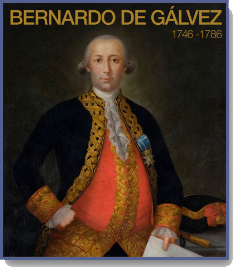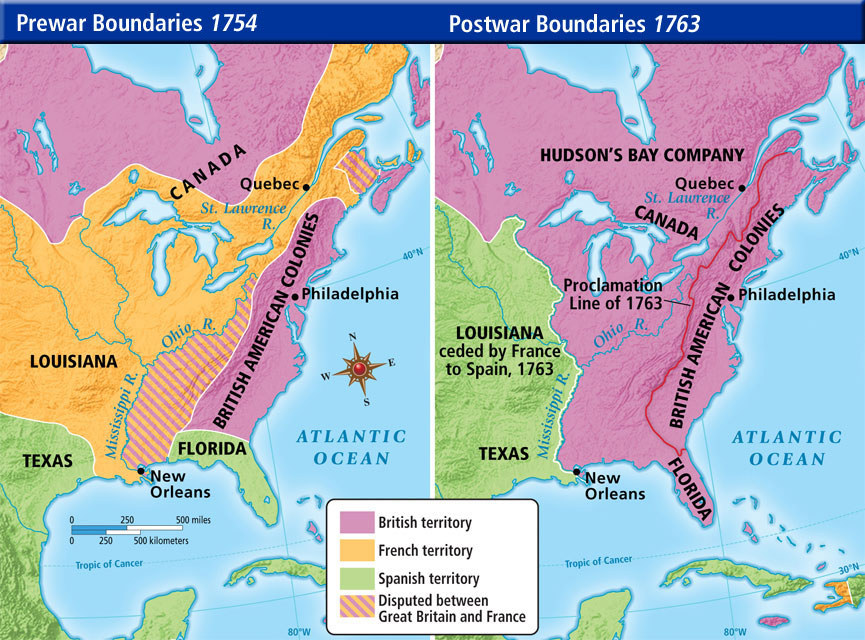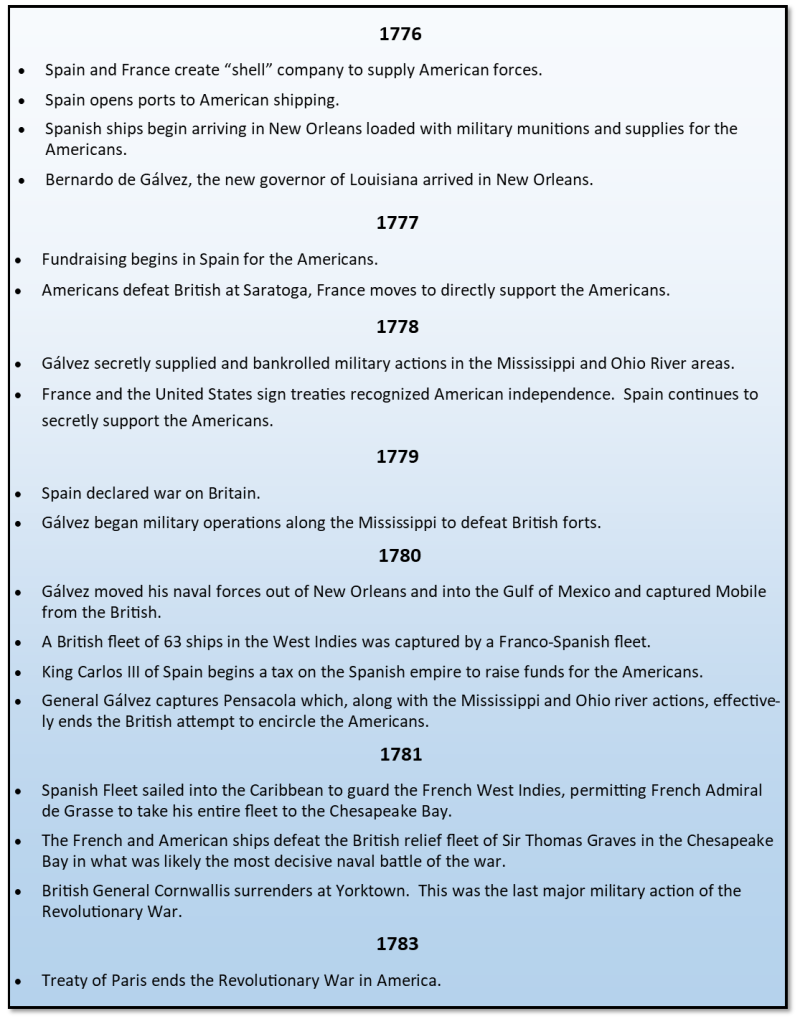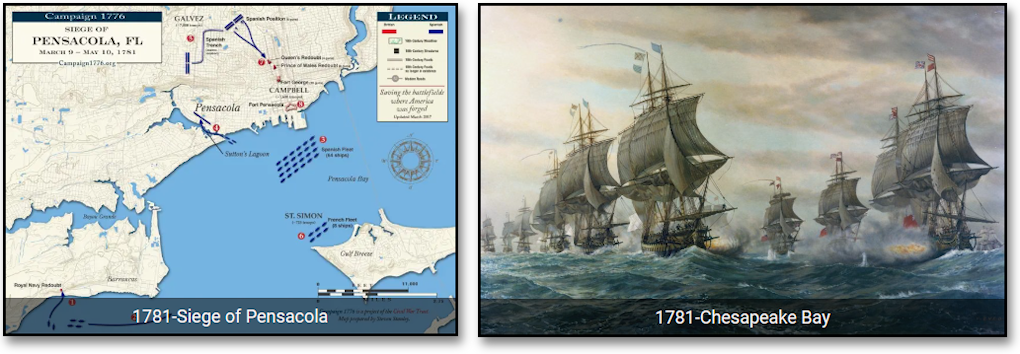 |
Spain’s Crucial Role in the American Revolution
 Spain’s role in the American Revolution has been understated in the history of the United States. This document provides information on the substantial but lesser-known role that Spain had in our independence. The information comes from published works by researchers that accessed original (or transcriptions of) historical documents in the U.S., Spain, France and other countries. This document is narrow in its focus as Spain’s involvement spurred actions and support for the American cause goes beyond what is listed here. Spain’s role in the American Revolution has been understated in the history of the United States. This document provides information on the substantial but lesser-known role that Spain had in our independence. The information comes from published works by researchers that accessed original (or transcriptions of) historical documents in the U.S., Spain, France and other countries. This document is narrow in its focus as Spain’s involvement spurred actions and support for the American cause goes beyond what is listed here.
Every attempt was made not to inject editorial or personal opinions rather this is a summary of the research that has been published on this topic.
Nothing in this document is meant to devalue the contribution of France or other countries to our Revolutionary War effort. The support of France was immense. Both France and Spain worked together to support the American Revolution and without their support the outcome of the Revolutionary War would have likely been quite different.
Why is this not Better Known?
There are at least two major reasons why the Spanish role is not as well-known as it deserves and does not seem to be a classroom topic.
- Spain did not want their role known until the latter stages of the Revolutionary War. They hid their support by funneling money and supplies through a private company that they, and the French, created for that sole purpose. Because of this, very little was published about Spanish support during the period.
- The direct military actions supported and conducted by Spain were in sparsely populated areas that had few, if any newspapers or writers. Most military actions were small with a limited number of witnesses. The numerous small actions played a significant role in the American war effort.
|
Background
- In 1762, under the “Treaty of Fontainebleau”, France ceded “French Louisiana” to Spain. By 1763 Spain occupied much of the new French Louisiana and was part of “New Spain” which consisted of the Louisiana and the continental North America west of the Mississippi River, “to the arctic snows”; and what is now Mexico and Central America.
- England claimed the 13 American colonies, parts of Canada, Bermuda, The Bahamas, Jamaica, Florida and West Florida, including some military positions on the east bank of the Mississippi River as far north as Natchez (now in Mississippi).
- England and Spain were traditional enemies, since at least 1588 when the British fleet under Lord Nelson and Admiral Sir Robert Cross defeated the Spanish Armada and the following year when British Admiral Cross captured the port of Cádiz.
- Spain lost Florida to England after “The Seven Years War”, which took place between 1756-1763, was a global conflict that spanned five continents. In America this war was known as the “French and Indian War”. The French and Indian war was ended by a treaty signed 1763 known as the “Treaty of Paris (of 1763)” and it resulted in the following:
- Spain regained Havana, Cuba which had been captured by the British.
- Britain obtained Spanish West Florida with Pensacola at its capital. West Florida included about two-thirds of what is now known as the Florida Panhandle along with the southern part of what is now Mississippi and Alabama.
 What were Spain’s Contributions to our Independence
- Spain provided funding to the American effort in the form of gold, silver, diamonds and Spanish currency. This was critical to the war effort. It is not an understatement to say that the outcome for our fight for independence would have been quite different without the funding that Spain provided.
- Along with the French Navy, Spain constantly harassed British ships at sea and routinely sailed into British home waters. This had the effect of “freezing” British forces in place as they might be needed if the actions turned hostile. The need to defend the homeland and the vast British empire kept a significant number of British forces and supplies away from America.
- The King of Spain asked all people under his rule to “donate” to the American cause and monthly collections were held around the world. The Mission San Diego al Alcala was involved in this effort along with all Spanish Missions in California.
- Spain shipped vast quantities of arms and ammunition to the Americans. The Continental Army and patriot militia units were in dire need of supplies throughout much of the war. Without the steady supply from Spain and France the Americans would not have been able to carry out as many military operations as they did.
- In addition to munitions, Spain provided clothing, food, footwear and raw materials as well as cash and credit on a regular basis.
- The Spanish Governor of West Louisiana, Bernardo de Gálvez, organized a military expedition from New Orleans up the Mississippi River to St. Louis and beyond. Their attacks and those they supplied on British installations drove the British from the Mississippi and Ohio River areas. This helped break the British plan to encircle the colonies and disrupt the French and Spanish supplies that were arriving in New Orleans and transported into the colonies.
- The forces Gálvez assembled consisted of regular Spanish soldiers and sailors, newly arrived recruits from Mexico and the Canary Islands, an assortment of Cubans, Dominicans, Puerto Ricans, free blacks, native Americans and other volunteers. As their efforts increased so did the size of Spanish forces in American.
- Gálvez undertook direct military actions by capturing the ports of Mobile and Pensacola which the British were using to supply their forces in their “Southern and Western Campaigns”. These actions were made by Spanish Navy ships, sailors and soldiers and Gálvez’s recruits along with land based Spanish and American forces.
- For the final major battle of the war at Yorktown, Virginia, where British General Cornwallis surrendered his forces, Spain played three pivotal roles:
- The first was providing the French Navy (and American forces) with money to continue. Both the American and French forces had not been paid in months and many were unwilling to continue the fight. Spain’s last-minute infusion of cash changed that.
- The second was that Spain sent their naval fleet to guard Caribbean Islands held by France. With Spain guarding their territory, the French fleet was free to assemble and sail an overwhelming force into Chesapeake Bay. This set the stage stage for a decisive Naval battle with the British Navy. With the larger fleet the French and American ships soundly defeated the British Navy.
- With the British Navy no longer a threat, the French sailed into the Yorktown area and participated in attacks on Cornwallis’s forces along with the American Continental Army which had marched from New York and attacked Yorktown from land. This effectively trapped Cornwallis on the small peninsula with no way out and no hope of supplies or fresh troops. He eventually was forced to surrender.
This was the last major battle of the Revolutionary War.
Timeline of Significant Actions
|
 |



 Spain’s role in the American Revolution has been understated in the history of the United States. This document provides information on the substantial but lesser-known role that Spain had in our independence. The information comes from published works by researchers that accessed original (or transcriptions of) historical documents in the U.S., Spain, France and other countries. This document is narrow in its focus as Spain’s involvement spurred actions and support for the American cause goes beyond what is listed here.
Spain’s role in the American Revolution has been understated in the history of the United States. This document provides information on the substantial but lesser-known role that Spain had in our independence. The information comes from published works by researchers that accessed original (or transcriptions of) historical documents in the U.S., Spain, France and other countries. This document is narrow in its focus as Spain’s involvement spurred actions and support for the American cause goes beyond what is listed here.